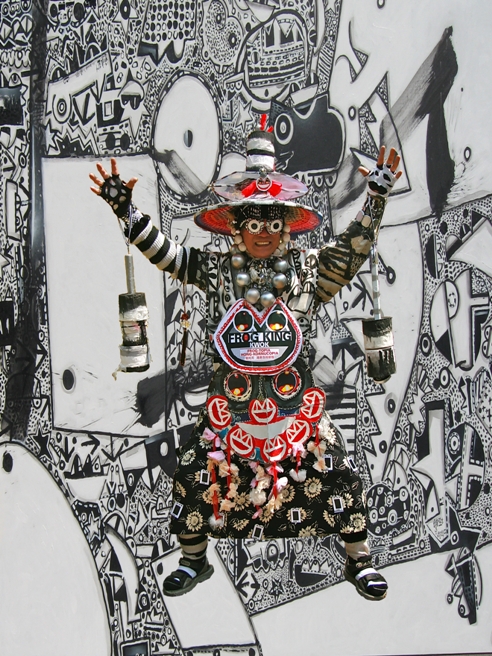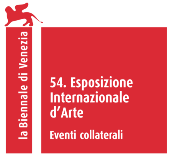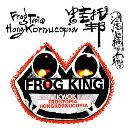
1. Frogtopia-Hongkornucopia, Hong Kong, 2011, Live art and body installation, Dimensions variable
Hong Kong Pavilion
Frogtopia.Hongkornucopia
Hong Kong at the 54th Venice Biennale
Introductory Text
Frogtopia o Hongkornucopia
Reading Frog King Kwok
Benny Chia
"Frogtopia" is a made-up word. "Topia" is taken from the Greek word "topos", meaning a place or topic, whereas "frog" is used as a symbol and recurring motif in Kwok's work. It symbolically alludes to a pair of bulging eyes that represent watchfulness, a bridge for exchange and communication, a sailing boat for going places, a broad grin for fun, a bra for support, and the like.
Frogtopia is a counter-place, not a make-believe place with a narrative. Kwok doesn't work with narratives. Even though he calls himself the Frog King, this name is not a reference to the Brothers Grimm's fairy tale. He started out by calling himself Frog King Kwok, which he used as a nom de guerre for his performance pieces. Later, to make it more family-friendly and proper, he took out "Kwok" to become simply Frog King.
Hongkornucopia, another made-up word in the exhibition's title, conjures up an image of the "cornucopia", a magical goat's horn with an inexhaustible store of fruits and grains coming out of it. Conversely, it may sound like some kind of medical condition. Hong Kong, where Kwok is based, is proffered as a metaphor of modern cityness which abounds with contradictions and multiplicities.
Kwok's initial impulse was to "take over the space" at the pavilion with "a forest" of expanding installation pieces, just like the trees at Angkor Wat
1.
Like the mirage of the ocean in Tarkovsky's "Solaris"
2, Kwok's reference to forests and trees is more of a reflection on anxieties related to space in overcrowded cities than the restorative properties of nature.
In a conversation with Zervos, Picasso posited that: "It's not what an artist does that counts, but what he is. (His) anxiety is what interests us. That is his lesson
3."
When using the Western medium, Kwok tends to fill up the space on his canvases like Pac-Man
4 eating up his monsters. He also over-produces, as if he deliberately wanted to defy the rarity and commercial value of his work, which he loves to give away.
He has to keep making and showing what he has made. It is almost a compulsion. The pace at which he makes his artworks is often like a toy factory before the Christmas shipments go out. He produces as many of them as a photographer who is taking multiple shots to get just one exactly right. The difference is that Kwok does not merely want to show only the right shots. He wants to show them all. They are all equal to him, for they are part of the process. It is the process of doing. Doing thus becomes for him a way of being. Doing recalls the image of the inexhaustible magical horn. Doing fills up that gnawing void.
In the display called 9Million+, a vast volume of his work is shown on several LED screens. They blink away in rapid succession. "And more is to come," he says. In volumising, he also hoards and fetishises objects and flotsam from relocating families or the newly deceased, and he turns some of them into artwork.
Kwok's facility in Chinese ink painting allows him to play and experiment with the medium, and be expedient with his subject matter and use of materials. He has constantly struggled to resist being drawn into making the kind of refined painterly pieces that are expected of Chinese literati artists.
He shrugs off the straitjacket of tradition and formality for Play and Fun in a society that instils among pre-schoolers the ethos that "Hard work is good. Play is no good."
5 What Kwok proposes is counter-culture.
In 2009, Kwok was invited to attend the Xi'an Qujiang International Contemporary Art Festival in the city of Xi'an. He turned up at the reception banquet wearing his shamanistic Frog King costume, complete with headgear and Froggy Sunglasses, in a grand hall full of dark-suited guests. Half way through the banquet, he went around the tables handing out stacks of blank A4 paper. "I motioned to them to throw the paper up in the air," Kwok says. Everyone joined in. "How can you resist?" he continues. In a moment, the banquet hall was lit up by white A4 paper cascading everywhere.
His play is so simple that it takes on a Zen-like purity. It is execution-focused rather than idea-based. There is no philosophising over the human condition. He is out to play with his audience in order to get their direct response. It is fun, pure and simple.
In his Froggy Sunglasses 10 Years Project, he takes snapshots recording his audience's complicity in playing a game of identity switch with him. He frames his audience engagement carefully, in order to keep it benign and non-aggressive. It is also a way of thumbing his nose at turgid self-importance and middle-class respectability.
He even makes unfashionable proclamations about Love and Happiness in his work, at the risk of being ridiculed. But Kwok is not one to proselytise. What he is espousing is the Taoist concept of Love and Happiness. One of the Taoist practices of healing and exorcism is to write or draw magical charms, which look arcane and indecipherable to the uninitiated. Kwok has pastiched their forms to develop a hybrid calligraphy that combines Chinese and English texts with invented symbols. Not only does he turn the pedantic application of calligraphy on Chinese scroll painting on its head, he also imbues his work with primitivism and hieratic power.
He resists putting proper finishes on his artwork. Instead, he prefers to use a stapler gun, sticking tape, lamination, photocopying, and photography. He takes snapshots of people he has met, his artwork, and food that his Korean artist wife Cho has prepared for him. He documents them painstakingly, and always carries them with him in bags of memory cards, as if he needs to provide evidence of his existence whenever such a question is raised.
The work on display presents Kwok as an artist who is more at the starting point than the finishing line. Shining a light in the void creates only an illusion of fullness.
1 This refers to the virulent growth of large tropical trees on the ruins of Angkor Wat, an ancient religious site in Cambodia. Frog King drew the analogy during a conversation in January 2011.
2 "Solaris", a cult movie directed by Andrei Tarkovsky (1972), based on a science fiction work of the same name by Stanislaw Lem.
3 Zervos, C. "Conversation avec Picasso", Cahiers d'art, 1935, X:7-10, p178.
4 In the eponymous video game, Pac-Man possesses a snapping mechanical mouth that eats up pac-dots known as "monsters" or "ghosts" as it moves up and down a maze.
5 "Qin you gong, xi wu yi", from the "Book of Three Characters", the first reading book for Chinese children since the Sung Dynasty.




